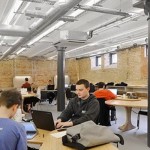 Co-working spaces are booming, with some 2.5m sq ft of co-working space in London alone at the moment. That’s an increase of 190% in the last year. Whilst the rise in the gig economy is an undeniable factor in this trend, there is also the promise of co-working providers that working in their facilities will make your work more creative and more effective. Great effort is put into designing spaces that are built to support innovation.
Co-working spaces are booming, with some 2.5m sq ft of co-working space in London alone at the moment. That’s an increase of 190% in the last year. Whilst the rise in the gig economy is an undeniable factor in this trend, there is also the promise of co-working providers that working in their facilities will make your work more creative and more effective. Great effort is put into designing spaces that are built to support innovation.
It’s a concept that has a lot to rationally support it. There is a strong need for flexible work spaces, and most facilities do look like superb places to plug into and work. Do they actually deliver on their promise though? Is the hype in the marketing material matched by reality on the ground? That was the question recently posed in a new paper by Creative Friction and the London School of Economics.
Sparking creativity
The report provides a number of key insights. Firstly, they believe that the very essence of creativity and innovation has shifted from formal organizations, and now has individuals and teams front and center.
The journey new ideas, products and services go through crosses multiple physical and organizational settings. By looking at this idea journey, it enables co-working spaces to analyze the precise role they play in the process.
“We show how abundant value can be created by co-working spaces when emerging ideas are going through the so-called elaboration stage,” the authors say. “In this phase, novel ideas need to be ‘nourished’ by high-quality interactions with diverse others; it is through such shared moments of creativity that member journeys can be accelerated and enhanced.”
As most people will interact with a wide range of physical and virtual workplaces however, it’s crucial that co-working spaces find a way of identifying the value that their specific space provides.
The report suggests however that the impact of the physical space on our creativity has been over-sold, and that social and digital elements play a bigger role. This rise in digital connectivity is helping people be both more mobile in their work patterns, and more motivated to find the ideal creative environment.
“For instance, a high share of coworking members belong to virtual teams that do not necessarily seek to be co-located but that might still benefit from bespoke support,” the authors say. “Also, to better support creative processes in a coworking context, members should be encouraged to co-develop local digital architectures.”
It’s also vital that co-working spaces do a better job of soliciting feedback from members as to the effectiveness of their spaces. The very aim of the facilities is to encourage collaboration between people that don’t ordinarily collaborate, so it’s crucial that providers better understand how effective they are being, especially given the diverse range of people attracted to the spaces.
“Every coworking space and collaborative organisation shapes the creative interactions and idea journeys of their members,” the authors conclude. “As this report has argued, the problem is that only very few have developed a mindful, systematic approach to fostering creative journeys – despite the ubiquity of creativity-focused branding.”